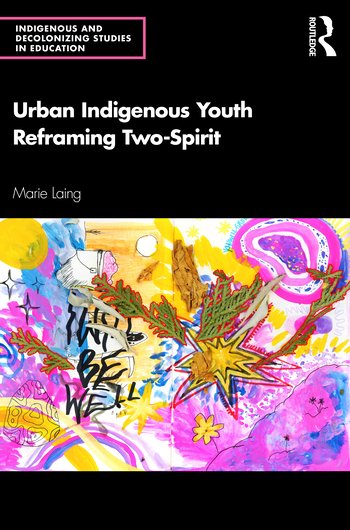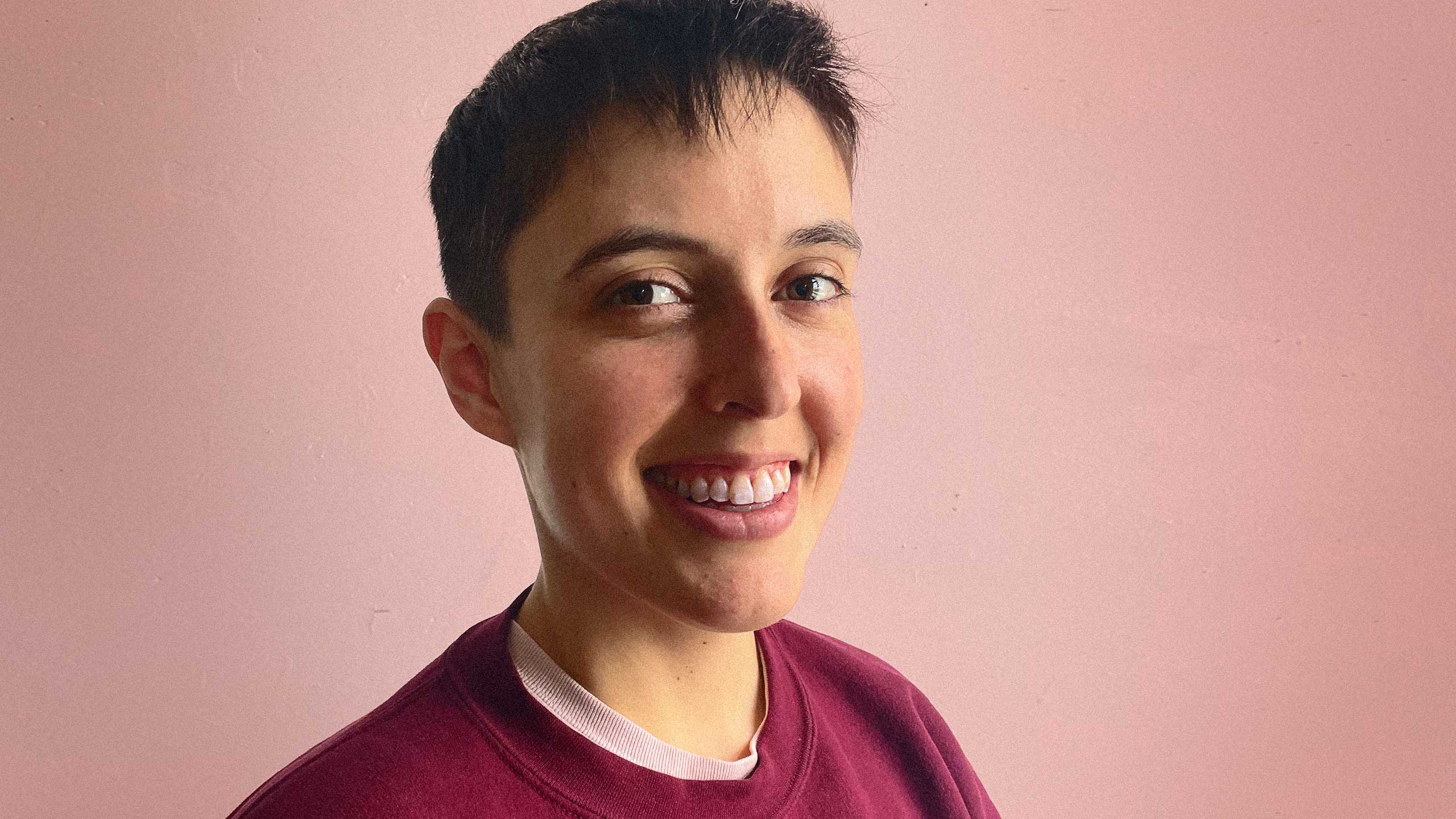The first question I ask queer Kanyen’kehá:ka author and educator Marie Laing about her recently released book, Urban Indigenous Youth Reframing Two-Spirit, is about the journey to get it published.
Instead of jumping into the process or detailing a moment of inspiration that led to the landmark text about queer Indigenous youth in Toronto, Laing begins by telling me where she and her family come from. The book, I can tell already, was not born in a single moment or from an individual experience.
Laing grew up in Kingston, Ontario, and her family is from Six Nations of the Grand River. She first completed her undergraduate degree at the University of Toronto’s department of sexual diversity studies. “The program was super white,” she says. “There was me and maybe like one other Indigenous student that I ever met or had a class with.” I hum and nod in understanding. As a current graduate student at the same university, it’s an experience that resonates.
Laing paints a picture of herself at this time as “a young queer, genderqueer, Indigenous person hearing the word Two-Spirit for the first time while reading Alex Wilson’s work.” Wilson, a professor at the University of Saskatchewan, has contributed some of the most revolutionary writing about Two-Spirit identity; her writing has been formative to my understanding of Indigenous queerness, too. Laing calls Wilson a “Two-Spirit rockstar,” and I have to agree.
It wasn’t long after this point that Laing began her master’s research, continuing to learn about Indigenous queerness as she had started in undergrad; the resulting thesis would inevitably form the basis of her book. She began studying social justice education at OISE (Ontario Institute for Studies in Education). “If you wanted to read a book about queer Indigenous people or what our history was,” she says, “all that was available for a long time was what these white anthropologists had written.” She sat with this realization: that apart from scholars like Wilson, there was a severe problem with the articulation of Two-Spirit identities in academia and in Canada.
“A lot of mainstream LGBTQ organizations at this time were starting to tack us (Two-Spirit people) onto their acronyms,” she recalls. “I kept seeing this single, very literal one-note definition of what Two-Spirit means: an Indigenous person with a male and female spirit.”
“I have long felt that Two-Spirit’s inability to be boxed into a static meaning is part of what makes it such a powerful, inherently queer term.”
The actual definition, though, is much more dynamic and complex. Often acknowledged as having been coined at the third annual Inter-tribal Native American/First Nations, Gay and Lesbian American Conference in Winnipeg in 1990 by elder and scholar Myra Laramee, “Two-Spirit” was introduced to give language to the unique experiences, identities and challenges of queer Indigenous people. It can mean something different depending on the person, the Nation and the experience. Many Indigenous queer and trans people don’t identify as Two-Spirit at all. I have long felt that Two-Spirit’s inability to be boxed into a static meaning is part of what makes it such a powerful, inherently queer term. Based on the chapter of her book, “Refusing the Question ‘What Does Two-Spirit Mean?’,” I believe Laing would agree.
We further discussed how white and Western understandings of Two-Spirit identity flatten the history and diversity of our communities, insisting that their definition sufficiently encapsulates what queerness means in First Nations cultures—as if there was only one culture, with one understanding of gender and sexuality.
This is where Laing’s Urban Indigenous Youth Reframing Two-Spirit comes in, and why it is so crucial. Seeing an opportunity to use her master’s studies to address these common misinterpretations, Laing says she “wanted to lift up some of those youth voices and make it so that there was a sizeable scholarly source that folks could go to, instead of like these whack pieces from the 1980s and ’90s, to talk about Two-Spiritedness.” That is precisely what she did.

She interviewed 10 queer, trans and Two-Spirit Indigenous youth in Toronto, putting their words, teachings, dreams and questions onto pages for others to learn from. The young people Laing interviewed described what Two-Spirit means to them personally, at that moment. Responses included using Two-Spirit to describe: the intersections of being Indigenous, transgender and queer; a sense of community or cultural responsibility attached to the role; and a space to claim complex forms of gender, to name only a few. Laing writes that “all participants agreed that Two-Spirit can describe a range of genders, sexualities and community roles.”
Laing was “very much writing to a dual audience of both Indigenous/Two-Spirit communities and also all of the white people. It was a harm-reduction moment of telling the latter audiences to stop citing these white anthropologists.” So instead of white anthropologists telling the world what Two-Spirit means, Two-Spirit Indigenous youth tell us. This book is exactly something teenage me, coming into my identity, was looking for.
Recognizing the importance that as many community members as possible be able to access this work, Laing also created a Zine version so, as she says, “folks could have a 30-page-or-so version that’s less labour to take in.” This is one example of how Laing grappled with the notion of accountability, a theme that comes up repeatedly as we speak.
Again and again, Laing recalls questions that she asked herself through her academic studies and writing: “Am I taking up too much space? What does it mean to be a responsible Indigenous person walking around looking like a white person all the time? What’s required of me? How do I be a responsible community member, essentially?” I know these questions have no easy answer, but they are nonetheless essential. It is one way to ensure we are aware of power and position in community spaces, necessary to ensure we are acting as good relations. My teachings tell me to do the same.
I ask Laing what her most significant shift was when creating the book. What knowledge did these young people share that made her look differently at the world and her place in it?
“I grew up very much brainwashed in the mentality that there are agents of power, all the white dudes in suits, who are in charge of everything,” she says. “And to change stuff, you just have to change their minds. I thought, ‘I’m going to get my degree in education. I’m going to change everybody’s minds.’” Instead, she found that “change isn’t going to come from white people understanding what Two-Spirit means. Change comes from when our community members can come together and share our ideas and create together.”
“It’s astonishing the revolutionary ways Indigenous youth, like those Laing interviewed, are causing such shifts in people’s minds and actions every day.”
About Two-Spirit people specifically, Laing says she is now convinced that “we are the ones who make the changes in our worlds that we need to survive and thrive and, in turn, make sure that our communities can survive and thrive.” A book that might initially appear to be about Two-Spiritedness is also about power, change and community creation. Reflecting on the whole experience, Laing tells me, “It was a very humbling lesson that was very much appreciated.”
It’s astonishing the revolutionary ways Indigenous youth, like those Laing interviewed, are causing such shifts in people’s minds and actions every day. Laing agrees: “As a 29-year-old, I feel like I’m just sitting on the porch with my little glass of iced tea and watching all of the Gen Zers make all of these changes. Being so radical with all of their activism and badassness. Having access to the internet and all of these types of connections to each other and different communities all over the world is really, I think, catalyzing a lot of change,” she says.
I wondered what Laing’s hopes were for Urban Indigenous Youth Reframing Two-Spirit. Her answer was straightforward and clear: that as many folks read it as possible. She hopes the book is useful and that community members can access it. The editors of the book, Eve Tuck and K. Wayne Yang, brilliant scholars of Indigenous thought, write in the intro, “Indigenous youth, steal this book.” “And I hope people do,” Laing says, laughing. “I hope that folks will be able to see themselves in it.”
Laing also hopes that publishing this book makes it more possible for other young Two-Spirit people to take up space in the publishing world—in academia and outside of it. Perhaps most interestingly to some, she hopes that people tell her she’s wrong. In her words: “That folks pick up the book and are like, ‘Marie, you’re wrong about these things; you needed to do more.’ And then they write their own book about all of those things.” Ultimately, the more queer Indigenous writing in the world, the better.
There is a lot to take away from my conversation with Laing, but I think one message is the most crucial. “Without queer and trans and Two-Spirit folks, the circle is not complete,” she says. “We are important, and we deserve to be valued. There are so many queer Indigenous youths doing important work that we really need.”
Laing is one of those queer Indigenous people doing such work. I am confident that just as Alex Wilson was a foundational voice for us, so too will Marie Laing be for generations to come. This book is both generous and generative. I am grateful that her work exists and was created with such heart and reverence for the young people who co-created it. If you want to learn more about Two-Spirit, I don’t think you’ll find a better source than Urban Indigenous Youth Reframing Two-Spirit.


 Why you can trust Xtra
Why you can trust Xtra


